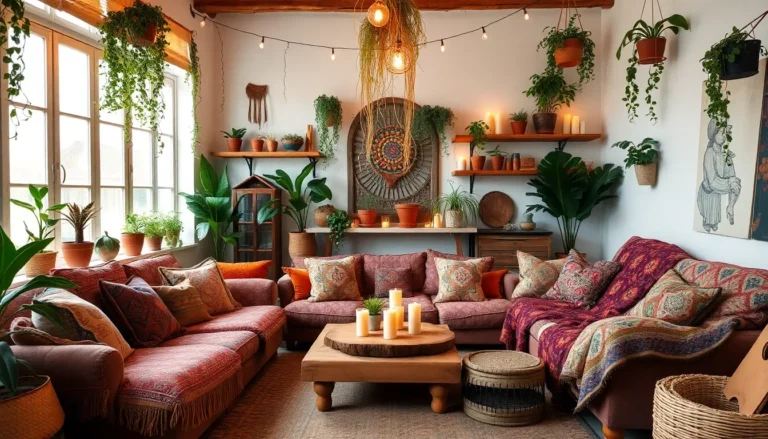Table of Contents
ToggleIn a world that never hits pause, carving out a self-care space at home isn’t just a luxury—it’s a necessity. Imagine a cozy nook where stress melts away faster than ice cream on a summer day. Whether it’s a plush chair with a good book or a meditation corner that whispers serenity, creating this sanctuary can transform chaos into calm.
Importance Of A Self-Care Space At Home
Creating a self-care space at home serves as an essential retreat in the hustle of daily life. Clarity arises when there’s a designated area focused solely on relaxation and rejuvenation. Difficult days can leave individuals feeling overwhelmed; a self-care space offers a sanctuary for mental and emotional recovery.
Dedicated corners can enhance mindfulness practices. Incorporating elements like soft lighting, calming colors, and decorative plants fosters an environment that promotes tranquility. Individuals experience reduced anxiety levels when they engage in activities such as reading or meditating in a soothing atmosphere. This intentional selection of space directly benefits overall well-being.
Prioritization of self-care boosts productivity. Individuals who invest time in relaxation often return to daily tasks with increased focus and creativity. Studies indicate that dedicated self-care practices can lead to improved mental health outcomes, reducing stress and promoting a sense of balance.
Flexibility in usage makes these spaces even more valuable. Whether it’s a moment spent journaling, doing yoga, or enjoying a warm beverage, individuals find personal meaning in how they utilize their space. The act of intentionally setting aside time contributes to mental wellness.
Overall, the significance of a self-care space at home cannot be overstated. It acts as a reminder to prioritize well-being amidst chaos. By practicing self-care in an intentional area, tranquility and personal growth become achievable goals, ultimately leading to a healthier lifestyle.
Key Elements Of A Self-Care Space
Creating a self-care space at home involves essential components that enhance well-being. Each element contributes to a nurturing environment.
Comfort And Relaxation
Comfortable seating plays a crucial role in fostering relaxation. Opt for a plush chair or a soft floor cushion for unwinding. Incorporate blankets to add warmth and coziness. Regarding lighting, use soft, dimmable options that create a serene atmosphere. Aromatherapy can elevate the experience; essential oils in a diffuser promote calmness. Dedicated spaces for activities like reading or meditating encourage consistent use. Elements that evoke positivity, such as soothing music or nature sounds, enhance tranquility.
Personalization And Style
Personalization in a self-care space promotes connection and ownership. Add artwork or photos that inspire joy and peace. Choose colors that resonate, such as pastels for calm or bold hues for energy. Incorporate meaningful objects, like treasures or mementos, to evoke positive memories. Select decor that reflects individual taste, whether minimalist or eclectic, ensuring the space feels uniquely theirs. Consider plants; greenery brings life and color while purifying the air. A personalized self-care space ultimately cultivates a sense of belonging and support for mindfulness practices.
Creating Your Ideal Self-Care Space
Establishing a self-care space at home transforms the environment, fostering relaxation and mindfulness. Key elements include assessing needs and selecting the right location.
Assessing Your Needs
Identifying personal preferences leads to a more effective self-care space. First, consider activities such as reading, meditating, or crafting. Each activity requires different materials or setups. Next, evaluate sensory preferences like light, sound, and scent. Some individuals thrive in bright environments, while others prefer dim lighting. Lastly, prioritize supplies. Create a list of items essential for your relaxation. This tailored approach ensures the space meets individual requirements.
Choosing The Right Location
Selection of an ideal spot plays a crucial role in your self-care journey. Begin by seeking quiet areas within the home, away from distractions. Evaluate spaces that receive natural light, as sunlight boosts mood and energy. Comfort is paramount, so look for areas with minimal foot traffic. Consider proximity to personal necessities, like water or favorite cushions. Flexibility matters; a designated space should adapt to changing needs over time.
Enhancing Your Self-Care Space
Creating a nurturing environment can significantly uplift one’s self-care experience. Individuals enhancing their space often prioritize elements that promote relaxation and peace.
Incorporating Nature
Bringing nature indoors fosters a sense of calm. Plants such as peace lilies and succulents improve air quality and add visual appeal. Incorporating natural materials like wood and stone can create a grounding effect. A small indoor water fountain can also introduce soothing sounds, enhancing tranquility. Positioning plants near windows allows natural light to nourish them and brighten the space. Using natural fibers for decor, such as cotton or jute, supports comfort and warmth. Each of these elements invites nature’s beauty and serenity, making the self-care space more inviting.
Adding Relaxing Scents
Scent plays a crucial role in creating a calming atmosphere. Essential oils like lavender and eucalyptus can significantly reduce stress levels. Using a diffuser or scented candles allows individuals to customize their space with fragrances that resonate. Additionally, incorporating incense can benefit relaxation during meditation. Choosing natural scents creates a sensory experience that soothes the mind. Other calming scents, such as chamomile or sandalwood, can also be effective. Surrounding oneself with pleasant aromas transforms the self-care space into a personal sanctuary.
Conclusion
Creating a self-care space at home is more than just a trend; it’s a vital practice for mental and emotional well-being. By carving out a dedicated area that reflects personal preferences and promotes relaxation, individuals can significantly enhance their quality of life. This sanctuary not only serves as a retreat from daily stressors but also fosters mindfulness and clarity.
Incorporating elements like soft lighting, calming scents, and natural materials can transform any corner into a peaceful haven. As people prioritize their self-care, they’ll likely find renewed focus and creativity in their daily tasks. Ultimately, a thoughtfully designed self-care space is an investment in a healthier and more balanced lifestyle.







